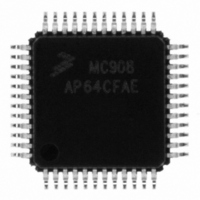MC908AP64CFAE Freescale Semiconductor, MC908AP64CFAE Datasheet - Page 175

MC908AP64CFAE
Manufacturer Part Number
MC908AP64CFAE
Description
IC MCU 64K 8MHZ SPI 48-LQFP
Manufacturer
Freescale Semiconductor
Series
HC08r
Specifications of MC908AP64CFAE
Core Processor
HC08
Core Size
8-Bit
Speed
8MHz
Connectivity
I²C, IRSCI, SCI, SPI
Peripherals
LED, LVD, POR, PWM
Number Of I /o
32
Program Memory Size
64KB (64K x 8)
Program Memory Type
FLASH
Ram Size
2K x 8
Voltage - Supply (vcc/vdd)
2.7 V ~ 5.5 V
Data Converters
A/D 8x10b
Oscillator Type
Internal
Operating Temperature
-40°C ~ 85°C
Package / Case
48-LQFP
Cpu Family
HC08
Device Core Size
8b
Frequency (max)
8MHz
Interface Type
SCI/SPI
Total Internal Ram Size
2KB
# I/os (max)
32
Number Of Timers - General Purpose
4
Operating Supply Voltage (typ)
3.3/5V
Operating Supply Voltage (max)
5.5V
Operating Supply Voltage (min)
2.7V
On-chip Adc
8-chx10-bit
Instruction Set Architecture
CISC
Operating Temp Range
-40C to 85C
Operating Temperature Classification
Industrial
Mounting
Surface Mount
Pin Count
48
Package Type
LQFP
Controller Family/series
HC08
No. Of I/o's
32
Ram Memory Size
2KB
Cpu Speed
8MHz
No. Of Timers
2
Embedded Interface Type
I2C, SCI, SPI
Rohs Compliant
Yes
Processor Series
HC08AP
Core
HC08
Data Bus Width
8 bit
Data Ram Size
2 KB
Maximum Clock Frequency
8 MHz
Number Of Programmable I/os
32
Number Of Timers
4
Maximum Operating Temperature
+ 85 C
Mounting Style
SMD/SMT
Development Tools By Supplier
FSICEBASE, DEMO908AP64E, M68CBL05CE
Minimum Operating Temperature
- 40 C
Package
48LQFP
Family Name
HC08
Maximum Speed
8 MHz
Operating Supply Voltage
3.3|5 V
Lead Free Status / RoHS Status
Lead free / RoHS Compliant
Eeprom Size
-
Lead Free Status / Rohs Status
Compliant
Available stocks
Company
Part Number
Manufacturer
Quantity
Price
Company:
Part Number:
MC908AP64CFAE
Manufacturer:
Freescale
Quantity:
3 359
Company:
Part Number:
MC908AP64CFAE
Manufacturer:
Freescale Semiconductor
Quantity:
10 000
Company:
Part Number:
MC908AP64CFAER
Manufacturer:
Freescale Semiconductor
Quantity:
10 000
TC — Transmission Complete Bit
SCRF — SCI Receiver Full Bit
IDLE — Receiver Idle Bit
OR — Receiver Overrun Bit
NF — Receiver Noise Flag Bit
Freescale Semiconductor
This read-only bit is set when the SCTE bit is set, and no data, preamble, or break character is being
transmitted. TC generates an SCI transmitter CPU interrupt request if the TCIE bit in SCC2 is also set.
TC is automatically cleared when data, preamble or break is queued and ready to be sent. There may
be up to 1.5 transmitter clocks of latency between queueing data, preamble, and break and the
transmission actually starting. Reset sets the TC bit.
This clearable, read-only bit is set when the data in the receive shift register transfers to the SCI data
register. SCRF can generate an SCI receiver CPU interrupt request. When the SCRIE bit in SCC2 is
set, SCRF generates a CPU interrupt request. In normal operation, clear the SCRF bit by reading
SCS1 with SCRF set and then reading the SCDR. Reset clears SCRF.
This clearable, read-only bit is set when 10 or 11 consecutive logic 1s appear on the receiver input.
IDLE generates an SCI receiver CPU interrupt request if the ILIE bit in SCC2 is also set. Clear the IDLE
bit by reading SCS1 with IDLE set and then reading the SCDR. After the receiver is enabled, it must
receive a valid character that sets the SCRF bit before an idle condition can set the IDLE bit. Also, after
the IDLE bit has been cleared, a valid character must again set the SCRF bit before an idle condition
can set the IDLE bit. Reset clears the IDLE bit.
This clearable, read-only bit is set when software fails to read the SCDR before the receive shift
register receives the next character. The OR bit generates an SCI error CPU interrupt request if the
ORIE bit in SCC3 is also set. The data in the shift register is lost, but the data already in the SCDR is
not affected. Clear the OR bit by reading SCS1 with OR set and then reading the SCDR. Reset clears
the OR bit.
Software latency may allow an overrun to occur between reads of SCS1 and SCDR in the flag-clearing
sequence.
caused by a delayed flag-clearing sequence. The delayed read of SCDR does not clear the OR bit
because OR was not set when SCS1 was read. Byte 2 caused the overrun and is lost. The next
flag-clearing sequence reads byte 3 in the SCDR instead of byte 2.
In applications that are subject to software latency or in which it is important to know which byte is lost
due to an overrun, the flag-clearing routine can check the OR bit in a second read of SCS1 after
reading the data register.
This clearable, read-only bit is set when the SCI detects noise on the RxD pin. NF generates an SCI
error CPU interrupt request if the NEIE bit in SCC3 is also set. Clear the NF bit by reading SCS1 and
then reading the SCDR. Reset clears the NF bit.
1 = No transmission in progress
0 = Transmission in progress
1 = Received data available in SCDR
0 = Data not available in SCDR
1 = Receiver input idle
0 = Receiver input active (or idle since the IDLE bit was cleared)
1 = Receive shift register full and SCRF = 1
0 = No receiver overrun
1 = Noise detected
0 = No noise detected
Figure 11-13
shows the normal flag-clearing sequence and an example of an overrun
MC68HC908AP Family Data Sheet, Rev. 4
I/O Registers
175











